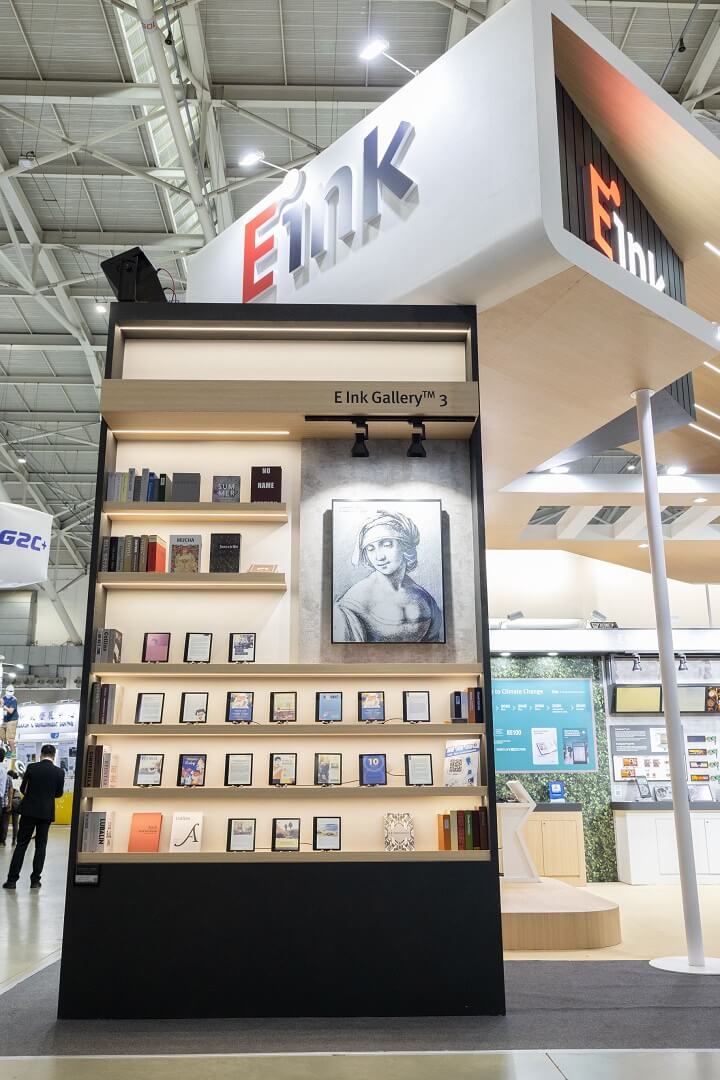TECHNOLOGY DESCRIPTION
Introduction
Learn more about E Ink and how our technology works.
How to Work with E Ink

Learn More.
FAQ
Learn more about E Ink and how our technology works.
-
What is E Ink?
E Ink is the creator of electronic ink — the optical component of a film used in Electronic Paper Displays. Although futuristic-sounding, electronic ink is actually a straightforward fusion of existing knowledge of chemistry, physics and electronics to create this new material. It's so much like paper, it actually utilizes the same pigments used in the printing industry today.
While E Ink has several types of electronic ink, we became best known for our microcapsule technology. In this system, the electronic ink is made up of millions of tiny microcapsules, about the diameter of a human hair. Each microcapsule contains positively charged white particles and negatively charged black particles suspended in a clear fluid. When a positive or negative electric field is applied, corresponding particles move to the top of the microcapsule where they become visible to the user. This makes the surface appear white or black at that spot. -
What does E Ink sell?
E Ink sells display modules to device makers who wish to integrate our reflective displays into their application. E Ink has two display platforms currently available – Segmented displays for applications that can utilize predefined segments that can be turned on or off, and Matrix displays, for applications that require the display of many different forms of text and images. For customers who are able to provide their own TFT or backplane integration, or for those looking for solutions in the architecture and design markets, we offer our films for sale. Contact sales for further information.
-
Do you have color ePaper products?
Yes, please refer to E Ink Color Products, or click E Ink Spectra, E Ink Gallery, E Ink Kaleido, E Ink Prism pages to find them.
-
What is the difference between an E Ink® display and an LCD display?
Simply put, E Ink displays reflect the ambient light in a room, exactly like printed paper, while LCD displays use a strong backlight that is modulated using liquid crystals. Because E Ink displays work like a printed page, they are not as tiring on eyes as an LCD screen.
-
What is the difference between an E Ink Matrix display and an E Ink Segmented display?
The underlying ePaper technology is very similar but is tuned to the needs of the different applications of a Matrix display versus a Segmented display.
Matrix displays are intended for applications requiring the display of many different forms of text and images. These displays comprise of a large array of pixels. These individual pixels are controlled by a TFT array similar to what you will have a typical computer monitor or TV screen.
Segmented displays are intended for applications where the display requirements can be met using predefined segments that can be turned on or off. This is similar to what one would see in a typical calculator with a numeric or alphanumeric display - the display be made up of an array of pixels or by a collection of predefined shapes. -
Does E Ink sell complete display modules or just the display film (E Ink film)?
E Ink actually sells both for matrix applications. You can order a fully assembled display module with a TFT attached to it. Or you can order just the cut E Ink film part which you will have to laminate to some form of electrical backplane like a TFT to control the electronic ink.
-
What is E Ink's minimum purchase quantity for Matrix displays?
This varies based on the size and requirements of the display application and whether it is a custom or standard size display. It is best to discuss your requirements with a member of our sales team.
Learn more about our standard modules. -
What is the pricing for E Ink Matrix displays?
Pricing for Matrix displays depends on volumes and whether the display is a custom or standard display. The main driver of pricing is the overall display size, whether the display is monochrome or color.
-
I have a project or application I want to develop. Can E Ink help?
This will vary depending on the project and the research involved. E Ink does engage in research projects and collaborative work through E Ink's internal research and development groups. These are usually projects that are aligned with our business goals.
-
How large/small can E Ink Matrix displays be?
The size and shape of an E Ink Matrix display is totally dictated by the size of the electrical backplane that the E Ink film is laminated to. Displays can be very small or very large. E Ink has standard display modules. Almost any size and shape can be made depending on the volumes.
-
What voltage is required to drive and E Ink Matrix display?
The drive for E Ink displays is typically 15 volts. An ecosystem of electronic components exists for design of complete ePaper systems.
-
How much power does an E Ink Matrix display consume?
E Ink Matrix displays are bi-stable. This means that they only consume power while the display is being updated. No power is required to maintain an image after it has been updated. The power required to for the update process depends on the size of the display but is of the order of microwatts.
-
Does E Ink have developer kits for Matrix products?
Yes there are developer kits available for Matrix products from E Ink and from our partners. Visit our kits webshop.
-
Does E Ink have a color product or is it only monochrome?
E Ink has several color products available.
E Ink also offers a three to five color product called E Ink Spectra, which is optimized for electronic shelf labels and point-of-purchase sale applications.
In addition, E Ink offers a one-color product called E Ink Prism, which is optimized for the Architecture market.
For full color, we have E Ink Gallery; and E Ink Kaleido in 4096 colors. -
How long does it take to update an image on an E Ink Matrix display?
An E Ink display module supports numerous modes for updating the display. Different modes exist to support the different update requirements. Update times can be as short as 120 ms. for the entire display. However, because E Ink screens are bi-stable, only the regions of the screen that are changing require updating. Any pixels that are not changing do not require updating.
-
Can an E Ink Matrix display support animation or video rates?
Using the faster update modes, E Ink screens can support animation quality video rates. A number of examples are available from customers that show examples of E Ink screens showing video. However, constant updates reduce the power efficiency of our ink systems. Current production modules do not support video rate updates.
-
Does E Ink provide or support flexible matrix displays?
The flexibility of an E Ink display is controlled by the backplane. E Ink offers a flexible plastic-based TFT product called E Ink Mobius, which can be utilized in a range of applications.
-
What is the thickness of an E Ink Matrix display?
Thicknesses range from 0.6 mm to 1.2 mm. This includes the E Ink film, protective sheet and the glass TFT backplane.
-
What is the temperature range for E Ink Matrix displays?
The operating temperature range for an E Ink Matrix display is from 0-50 °C.
-
Does E Ink have standard Segmented displays?
E Ink has several standard parts available. Learn more here.
-
Does E Ink develop prototype Segmented displays?
For those customers who are investigating an E Ink Segmented application, we provide a prototype development program. E Ink works with customers to finalize the specifications for the desired display. Based on the specifications E Ink will provide a quote for the prototype design. Upon completion of the specifications and quote acceptance, first working samples can typically be delivered in 10 weeks. At the completion of the prototype, per unit mass production pricing is finalized.
-
Can I use E Ink Segmented displays for academic research, educational projects, or personal use?
Yes, we recommend that you use one or more of our standard displays. Please visit our kits webshop.
-
How large/small can E Ink Segmented displays be?
The smallest Segmented display dimensions are approximately 6mm X 6mm. The largest display is 600mm x 600mm.
-
What voltage is required to drive and E Ink Segmented display?
Segmented displays can be driven typically 15 volts.
-
How much power does an E Ink Segmented display consume?
E Ink Segmented displays are bi-stable; they do not consume power after an update. It takes of the order of microwatts to switch from one display state to another.
-
What is the minimum number of segments that can be created with E Ink?
Ink Segmented displays range from 1 to hundreds of segments.






